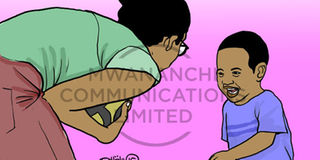PARENTING : Things to do to raise a happy child

What you need to know:
Edward Hallowell, psychiatrist and author of The Childhood Roots of Adult Happiness, says over-indulged children — whether showered with toys or shielded from emotional discomfort — are more likely to grow into teenagers who are bored, cynical, and joyless.
What makes children happy may surprise you. Child development experts say that happiness isn’t something you give children — it’s something you teach them.
Edward Hallowell, psychiatrist and author of The Childhood Roots of Adult Happiness, says over-indulged children — whether showered with toys or shielded from emotional discomfort — are more likely to grow into teenagers who are bored, cynical, and joyless.
“The best predictors of happiness are internal, not external,” says Hallowell, who stresses the importance of helping kids develop a set of inner tools they can rely on throughout life.
The good news is you don’t have to be an expert in child psychology to impart the inner strength and wisdom it takes to cheerfully weather life’s ups and downs. With patience and flexibility, any parent can lay the groundwork for a lifetime of happiness.
Learn to read your child’s emotions
When your child was a baby and toddler, you probably had a good sense of whether he was happy or sad. Now that he’s older, his emotions are more complex. But fortunately, his ability to control them is a lot stronger. Still, the outward signs of whether he’s happy or unhappy are not hard to read. A happy child smiles, plays, shows curiosity, socializes with other children, and doesn’t need constant stimulation.
Conversely, says Hallowell, the signs of an unhappy child are clear: The child “is withdrawn, quiet, not eating very much, doesn’t spontaneously get involved with other children, doesn’t play, doesn’t ask questions, doesn’t laugh and smile, and has very spare speech.”
If you have a naturally shy or introverted child who doesn’t laugh or interact a lot, that doesn’t mean he’s unhappy. Shyness is not the same as sadness, but you’ll have to work harder to read his signs. Hallowell says to be aware of any major changes in his behavior — becoming more isolated or fearful — that might suggest he’s having problems you should pay attention to.
Paul C. Holinger, professor of psychiatry a, has identified nine inborn “signals” that babies use to communicate their feelings. You can recognize these signals in your older children also. Two of the signals, “interest” and “enjoyment,” are positive feelings, while the negative signals, especially “distress,” “anger,” and “fear,” add up to an unhappy child.
Most parents recognize that a fearful, easily upset child isn’t a happy camper, but Holinger finds that many parents don’t recognize that an angry child is usually expressing sadness. No matter the age, “anger is simply excessive distress,” says Holinger. When your child hits his brother or yells “I hate you!” it means he’s distressed beyond his ability to deal with it.
Your child probably has his own ways of showing you when he’s going through a hard time. Some kids may withdraw, some may lash out, and still others may become clingy. As you get to know your own child’s temperament, you’ll become better at learning the signs that something’s not right in his world.
Have fun with your child
If your child took a minute to think about her happiest times, she would probably realize that what makes her happiest is you. And that’s the first key to creating a happy child says Hallowell. “Connect with them, play with them,” he advises. “If you’re having fun with them, they’re having fun. If you create what I call a ‘connected childhood,’ that is by far the best step to guarantee your child will be happy.”
Play creates joy, but play is also how your child develops skills essential to future happiness. Unstructured play allows her to discover what she loves to do — build cities out of blocks, teach math to her stuffed animals — which help her cultivate interests that can last a lifetime.
Help your child master new skills
Hallowell’s prescription for creating lifelong happiness includes a surprising twist: Happy people are often those who have mastered a skill. For example, when your child practices riding a bike, he learns from his mistakes, he learns persistence and discipline, and then he experiences the joy of succeeding due to his own efforts.
He also reaps the reward of gaining recognition from others for his accomplishment. Most important, he discovers he has some control over his life: If he tries to do something, he has the satisfaction of finding that, with persistence, he can eventually do it. Experts say this sense of competence creates self-confidence.
Email: [email protected]




